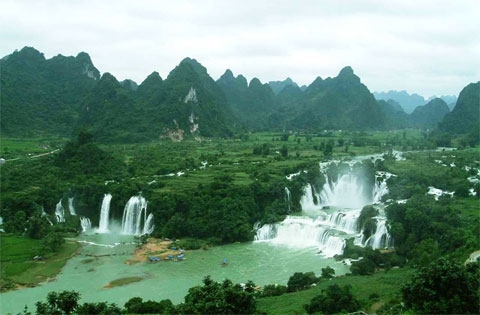Trung Khanh, a mountainous district in Cao Bang Province , 332km from Hanoi to the northeast, houses many beautiful landscapes, specialities and rare and precious animals of the subtropical primeval forest.
Standing at the peak of Ma Phuc Pass , 620 metres above sea level, it’s possible to see two stone blocks resembling a pair of horses standing face to face and a floristic composition covering the mountain and valley.
Also, the 32km-long Quay Son River runs through the region, not only bringing silt to a large rice-growing area but also providing water for chestnut forests laden with fruits. The fruit, as big as rambutan, has many hard thorns and contains 3-4 chestnuts, each being 4-5 times bigger than the normal castanea.

Trung Khanh attracts tourists who like ecological, geological and adventurous tourism because it boasts many waterfalls and marvellous caves. Particularly, it has been famous for Ban Gioc Waterfall, hundreds of metres in height and width.
In the rainy season, its water runs into three flows, one pouring slightly like a silk ribbon and the others rushing in noisily. On sunny days, white water sprays create a sparkling and mysterious rainbow. About 3km from Ban Gioc Waterfall is Nguom Ngao Cave that has many marvellous landscapes complete with stalactites and stalagmites of great geological values.

In recent years, Trung Khanh has attracted a number of scientists from home and abroad due to its bio-diversity of subtropical evergreen primeval forests of seven types. Of which, four types have 15 varieties of plants that are the source of food of the Cao Vit gibbon (scientifically known as Nomascus nasutus nasutus), one of the most rare primate species in the world.
According to a survey conducted in Ngoc Khe and Phong Nam Communes in the north of Trung Khanh in 2002-2007 by the Fauna and Flora International (FFI), Trung Khanh is now home to 17 groups of Cao Vit gibbons with nearly 100 individuals. Nguyen The Cuong who works for FFI said that this species of gibbon is very unique because they do not have a tail.

To protect the rare primate, a conservation area was established in April 2007 with a total area of 1,656.8ha, including a flora area of 543 varieties and a fauna area of 23 animals under 14 families, 61 species of birds, 11 species of reptiles under 10 races, of which 10 species were listed in the Red Book of the International Union for Conservation of Nature (IUCN) in 2006.
Once visiting Trung Khanh, tourists will never forget moments of relaxing among wild nature, beholding beautiful landscapes with white pear flower and listening to birdsongs.
Source: Vietnamvnanet
(84-63) 3 826042 – (84-63) 3 511142
No 54 Nguyen Dinh Chieu, Ham Tien Central Mui Ne Beach Binh Thuan Vietnam
523 To Hien Thanh District 10 Ho Chi Minh City Vietnam
Ha Long Halong City Quang Ninh Vietnam
A13 Hung Thong 2 Halong City Quang Ninh Vietnam




